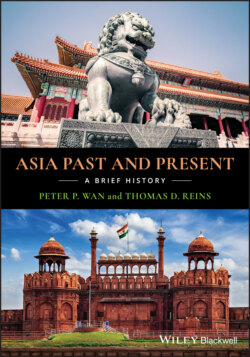Читать книгу Asia Past and Present - Peter P. Wan - Страница 21
Pastoral Nomadic Culture
ОглавлениеNomadic herding of animals as a livelihood for a small part of humanity likely began not long after the advent of farming. However, the mature pastoral nomadic existence that developed to the north of civilization in Asia—across the Eurasian steppe—resulted from two basic causes: (1) the vanishing of hunting territory, which occurred because growers in Neolithic and Civilized settings consumed lands favorable to foraging; and (2) the domestication of the horse and camel about 2000 BCE, which made possible mobility across the steppe grasslands. Not only did hunters and gatherers get pushed off their lands by farmers, thus requiring these foragers to find another occupation; but planters also forced many of their fellow planters to the margins of agricultural subsistence, compelling many of them to take up a fresh line of work. In both cases, that new livelihood often involved herding on lands with only minimal access to water.
In Asia, pastoral nomadism is associated with the Eurasian steppe, grassy grazing land north of China and India that stretches east from the Ural Mountains to the Pacific Ocean. This includes most of today’s Central Asia, southern Siberia, and Mongolia, where bands of a hundred or so kinfolk migrated via horse, camel, or wagon, leading the herd to the most likely locations offering water and fodder. Typically they herded sheep, goats, yaks, and cattle for the products they turned out, such as milk and its products, as well as meat for food, hides for clothing and yurts, and animal waste for fuel. These nomads characteristically came from Turkish, Mongolian, Manchu, Uighur, Hun, or Xiongnu backgrounds by the beginning of the Common Era. By that time, the Indo‐Europeans from the steppe had migrated into India, Iran, or Europe. These nomads remained significant political and economic influences in Asia into the twentieth century.
Life on the steppe consisted of constant battles. The most common clash pitted nomad against nature. The sky provided the most essential product, rainwater, without which animals and humans perished. The rain also made possible the feed that sustained animals and herders. This meant migration as either water or fodder became insufficient in a particular area. Heat, cold, and wind also habitually challenged human and animal existence. As bands moved around the steppe in search of shelter or provisions necessary for survival, they encountered other bands in search of the same, often resulting in violent clashes. Quite often as well, fighting among band members added to the list of brutality that bands characteristically suffered. And eventually, pastoral nomads and civilized cultures collided. Although the two different ways of life regularly interacted to their mutual benefit, usually involving trade, they also often clashed.
These struggles had many causes, including famine on the steppe or instability in civilized settings. Most civilizations employed terms of scorn to characterize their nomadic neighbors, the most common one being “barbarian.” Typically civilizations kept the nomads at bay, but occasionally nomads conquered and sometimes ruled their civilized neighbors. Life of the pastoral nomad changed very little from the introduction of the horse down to the twentieth century. The last emperor of the last dynasty in China was a Manchu, originally a pastoral nomadic/semi‐agrarian people from Manchuria, and their Manchu Qing Dynasty survived until 1912.
